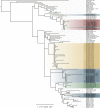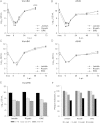An observational, laboratory-based study of outbreaks of middle East respiratory syndrome coronavirus in Jeddah and Riyadh, kingdom of Saudi Arabia, 2014
- PMID: 25323704
- PMCID: PMC4303774
- DOI: 10.1093/cid/ciu812
An observational, laboratory-based study of outbreaks of middle East respiratory syndrome coronavirus in Jeddah and Riyadh, kingdom of Saudi Arabia, 2014
Abstract
Background: In spring 2014, a sudden rise in the number of notified Middle East respiratory syndrome coronavirus (MERS-CoV) infections occurred across Saudi Arabia with a focus in Jeddah. Hypotheses to explain the outbreak pattern include increased surveillance, increased zoonotic transmission, nosocomial transmission, and changes in viral transmissibility, as well as diagnostic laboratory artifacts.
Methods: Diagnostic results from Jeddah Regional Laboratory were analyzed. Viruses from the Jeddah outbreak and viruses occurring during the same time in Riyadh, Al-Kharj, and Madinah were fully or partially sequenced. A set of 4 single-nucleotide polymorphisms distinctive to the Jeddah outbreak were determined from additional viruses. Viruses from Riyadh and Jeddah were isolated and studied in cell culture.
Results: Up to 481 samples were received per day for reverse transcription polymerase chain reaction (RT-PCR) testing. A laboratory proficiency assessment suggested positive and negative results to be reliable. Forty-nine percent of 168 positive-testing samples during the Jeddah outbreak stemmed from King Fahd Hospital. All viruses from Jeddah were monophyletic and similar, whereas viruses from Riyadh were paraphyletic and diverse. A hospital-associated transmission cluster, to which cases in Indiana (United States) and the Netherlands belonged, was discovered in Riyadh. One Jeddah-type virus was found in Riyadh, with matching travel history to Jeddah. Virus isolates representing outbreaks in Jeddah and Riyadh were not different from MERS-CoV EMC/2012 in replication, escape of interferon response, or serum neutralization.
Conclusions: Virus shedding and virus functions did not change significantly during the outbreak in Jeddah. These results suggest the outbreaks to have been caused by biologically unchanged viruses in connection with nosocomial transmission.
Keywords: MERS-coronavirus; nosocomial transmission; outbreak; transmission infection control; virus isolation.
© The Author 2014. Published by Oxford University Press on behalf of the Infectious Diseases Society of America. All rights reserved. For Permissions, please e-mail: journals.permissions@oup.com.
Figures




Comment in
-
Critical contribution of laboratories to outbreak response support for middle East respiratory syndrome coronavirus.Clin Infect Dis. 2015 Feb 1;60(3):378-80. doi: 10.1093/cid/ciu815. Epub 2014 Oct 16. Clin Infect Dis. 2015. PMID: 25323703 Free PMC article. No abstract available.
References
-
- Zaki AM, van Boheemen S, Bestebroer TM, Osterhaus AD, Fouchier RA. Isolation of a novel coronavirus from a man with pneumonia in Saudi Arabia. N Engl J Med. 2012;367:1814–20. - PubMed
-
- MERS-CoV. 2014. ProMed-Mail 20140325.2356854. Available at: http://www.promedmail.org/ . Accessed 25 March 2014.
-
- European Centre for Disease Prevention and Control Severe respiratory disease associated with Middle East respiratory syndrome coronavirus (MERS-CoV); 9th update, 24 April 2014. 2014. Stockholm, Sweden: European Centers for Disease Control, Available at: http://www.ecdc.europa.eu/en/publications/Publications/Middle-East-respi... .
-
- Corman VM, Eckerle I, Bleicker T, et al. Detection of a novel human coronavirus by real-time reverse-transcription polymerase chain reaction. Euro Surveill. 2012;17 pii:20288. - PubMed
-
- Corman VM, Muller MA, Costabel U, et al. Assays for laboratory confirmation of novel human coronavirus (hCoV-EMC) infections. Euro Surveill. 2012;17 pii:20285. - PubMed
Publication types
MeSH terms
Associated data
- Actions
- Actions
Grants and funding
LinkOut - more resources
Full Text Sources
Other Literature Sources

